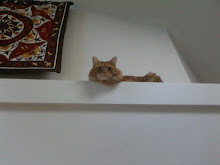Above is shown a map of the area in which I think most of the battles between my ImagiNations will take place. It includes the Cockpit around Kimmelsbrucke in the center-south, and the Free County of Cottbus in the north. Ground scale is one hexagon = 10 miles, so the map covers a region of 100 miles east-west x 110 miles north-south. The two countries extend by about 100 miles either side of the area shown. Their common border is the River Eisenwasser, which flows south to north and is navigable for much of its length.
*
The Cockpit is noted for a number of mines which form an essential part of the national economies for both sides and, naturally, they also make for juicy objectives in wartime. The major towns are shown; for clarity many smaller communities have been omitted. Two principal towns in this area are Kimmelsbrucke with its famous bridge, and Randstadt.
~
Kimmelsbrucke has been a major crossing point of the Eisenwasser for generations and is a wealthy town as a consequence of the taxes and tariffs generated by river and road traffic. It's also the main market town for the agricultural industry focused on the fertile alluvial plain of the river, and handles much of the produce from the silver mine at Wohl. However, the town council is notoriously parsimonious, and this wealth has not been spent on updating the town's fortifications to any extent. It still relies upon medieval walls with some more modern additions for defense.
~
About twenty miles away in the Margravate the town of Randstadt is rather different. Occupying a plateau overlooking the tributary River Randwasser, it has a naturally commanding position not unlike Vicksburg in Mississippi. Modern fortifications in the Vauban style protect the main circuit of the town, and two batteries of fortress artillery cover the river. A riverine navy base is located within the eastern end of the town defenses, and boats from this maintain customs patrols on the river as far as the confluence with the Eisenwasser. The city is also quite wealthy through local agriculture and viticulture, and the products of the iron and lead mines in the region. The wharfs along the river are busy almost 24/7. There is a constant level of irritation in Randstadt over the high tariffs charged by Kimmelsbrucke on Margravate barge traffic to the sea at Cottbus.
*
The Free County & City of Cottbus is one of many autonomous statelets. Possessing a natural advantage of being at the mouth of the River Eisenwasser, it makes full use of its location as an entréport while jealously preserving and protecting its autonomy. Unlike Kimmelsbrucke, the city has made use of its wealth to maintain and upgrade its defenses to modern standards, although they rely upon a well-equipped militia and hired mercenaries to man those defenses at need. A small flotilla of oared gunboats patrols the estuary and the length of river within the borders.
~
Cottbus became a Free City when the previous ruler, Count Oswald von Cottbus died without issue in the break-up of the Empire. The legal confusion over its status was lost in the turmoil and the City Fathers took advantage of it over the years. They do harbor a constant dread that someone, somewhere, will discover a legitimate claim to their city and its lands, and have prepared a vigorous legal case in their favor if needed. Cottbus is therefore something of a Mecca for practitioners of international law. The City Fathers know they would live on borrowed time if a claimant with any real power were to ignore legal niceties and launch a direct assault. Their defenses are among the best, but they won't hold out forever.
*
Next time, I'll cover the western half of the Grand Duchy, including the Capital itself and the Bishop's City of Waldorf-Salle-Ads, where some say all the trouble began...








